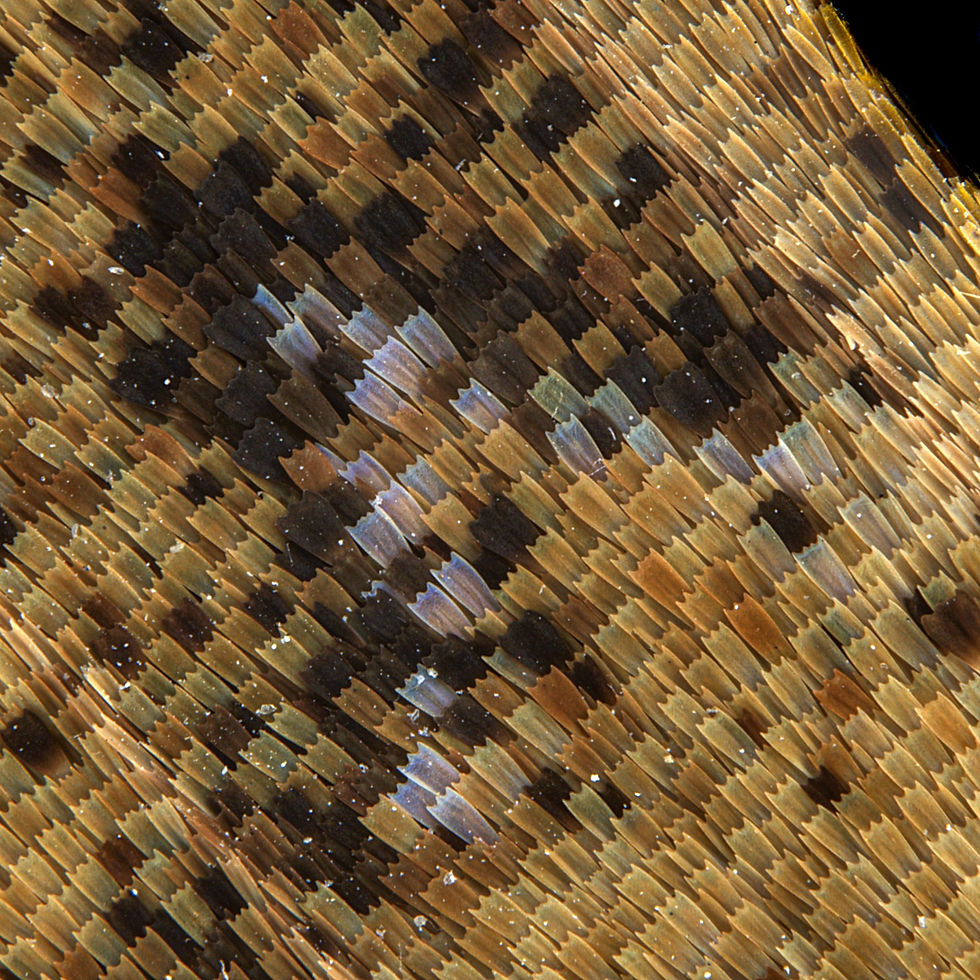Specimen Showcase | Master of Camouflage
- Hong Kong Biodiversity Museum

- Mar 10
- 4 min read
Imagine a butterfly that can transform into a dead leaf whenever it needs to disappear—meet the Orange Oakleaf butterfly 𝘒𝘢𝘭𝘭𝘪𝘮𝘢 𝘪𝘯𝘢𝘤𝘩𝘶𝘴 Boisduval, 1836. This incredible insect takes camouflage to an entirely new level. From its unique body size to its mind-blowing wing patterns and seasonal transformations, the Orange Oakleaf is truly one of nature’s most impressive magicians. Let’s explore what makes this butterfly so special and how it stands out from its colorful, fluttering cousins.
Native to tropical Asia, this butterfly’s distribution ranges from India to Japan, extending across countries like China, Thailand and Vietnam. The Orange Oakleaf thrives in dense tropical forests with high rainfall and thick vegetation, where it finds ample shelter and camouflage opportunities.

Many butterflies are known for their bright, eye-catching colors, but the Orange Oakleaf has a secret weapon: invisibility. Well, sort of. When its wings are closed, this butterfly looks exactly like a dry, crumpled leaf. We’re talking veins, brown patches, and even little spots that resemble mold or lichen, just like a real dead leaf you’d find on the forest floor. This remarkable camouflage isn’t just for show, it’s a defense mechanism that keeps predators like birds, spiders, and ants from realizing it’s there.

But here’s the twist: when it opens its wings, it’s a totally different butterfly. The topside of its wings shows off a striking combination of bright orange, deep blue, and velvety black. It’s like the butterfly has two outfits, one for blending in and one for showing off. This two-toned look is what sets the Orange Oakleaf apart from most other butterflies, as few can pull off both camouflage and vibrant colors so effortlessly.

In terms of body size, the Orange Oakleaf is on the larger side for a butterfly. Its wingspan can range from 85 to 110 mm, making it pretty noticeable, at least when its wings are open. Interestingly, females tend to be larger than males, a phenomenon known as sexual dimorphism. This size difference is likely to help females carry more eggs, while males stay smaller and more agile, better suited for chasing down potential mates.
The larger body size of the females also ties into their ability to hide effectively. A bigger "leaf" is easier to spot, right? But the Orange Oakleaf has perfected its mimicry to such an extent that even the larger females can blend in with dead leaves just as well as their male counterparts. The larger wings also help females travel further in search of ideal egg-laying spots, which is essential for ensuring the next generation.

Large predators like birds or lizards aren’t the only ones after this butterfly. Caterpillars are particularly vulnerable, as they don’t have the same level of disguise as the adult form. However, the caterpillars do have their own form of protection, black bodies covered in reddish spines and yellowish hairs. These spines, along with their velvety texture, help protect them from some predators by making them less appealing to eat or for parasitoids to lay their eggs.

As larvae, the caterpillar diet consists mainly of leaves from plants in the Acanthaceae family (e.g. 𝘚𝘵𝘳𝘰𝘣𝘪𝘭𝘢𝘯𝘵𝘩𝘦𝘴 genus).They’re voracious eaters, consuming as much plant material as possible to fuel their rapid growth. Once they’ve eaten their fill and gone through several growth stages, it’s time for the final big transformation, metamorphosis.
In contrast, adult Orange Oakleaf butterflies have a much simpler diet, mainly feeding on nectar from flowers. This shift to a liquid diet sustains the adult’s energy needs, allowing it to focus on essential mating and egg-laying behaviors. This dietary shift is typical of many butterfly species, as the energy demands and dietary needs differ significantly between the caterpillar and adult stages.

The Orange Oakleaf also presents wing-size and colour variations depending on the season they emerge. During the dry season, the butterfly’s wings are larger and paler, helping it blend in with the dry, brown leaves on the forest floor. In the wet season, the wings are smaller and darker, matching the lush green foliage of the rainy season. This seasonal change, known as seasonal polyphenism, helps the butterfly adapt to its surroundings and survive in a variety of conditions. The larger wings during the dry season help it travel further in search of food, while the smaller wings during the wet season conserve energy in the more resource-rich environment.

In a world of vibrant colors, the Orange Oakleaf reminds us that sometimes the greatest beauty is hidden in plain sight. So, the next time you spot a fallen leaf, pause for a moment you might just be witnessing one of nature’s most brilliant tricksters, ready to spread its wings. If you enjoyed this post, be sure to share it and follow us for more fascinating insights into the natural world!
Text: Amber Grace




Comments